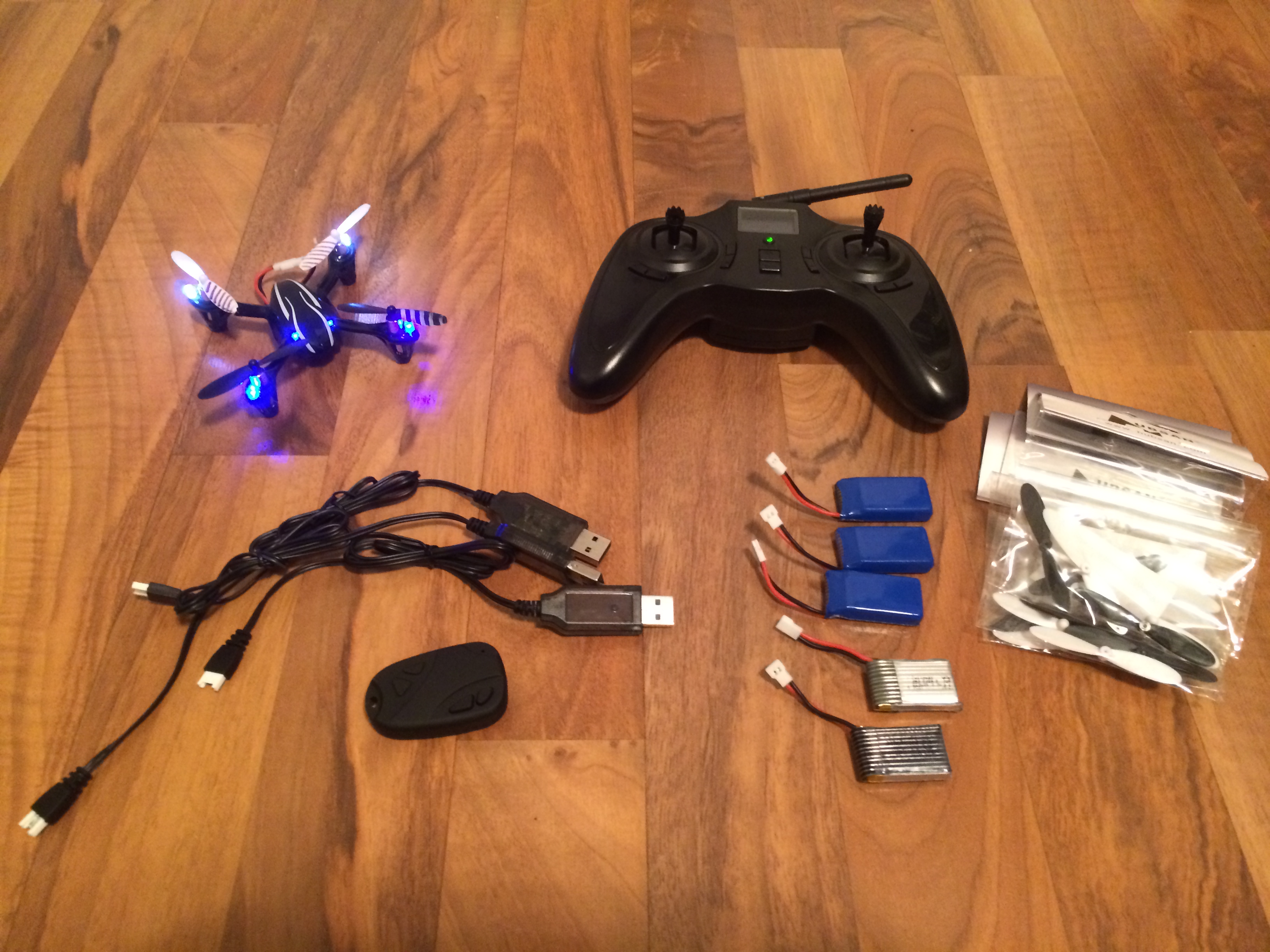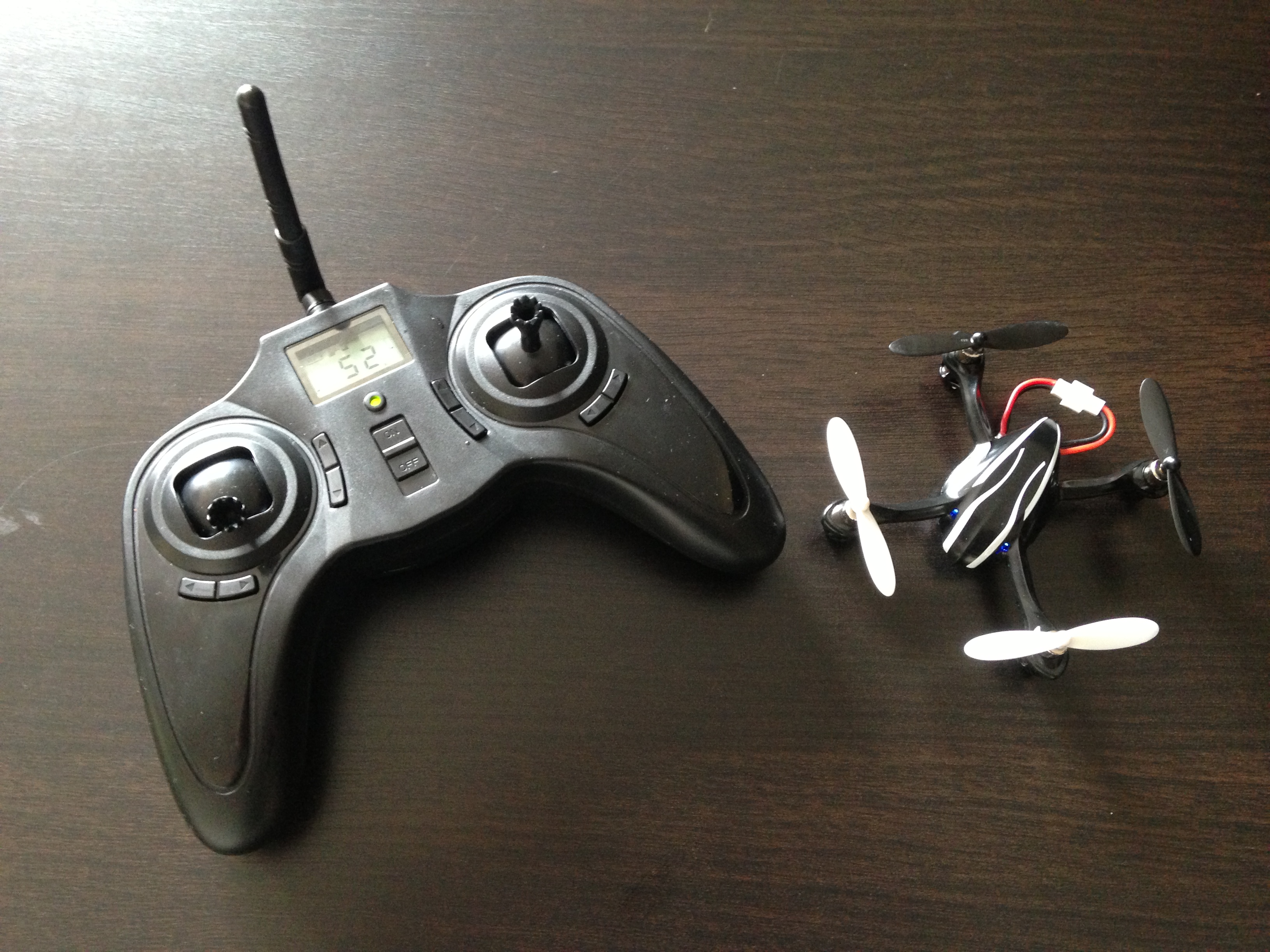Edit: this page is long out of date. For a more recent overview please read this Reddit thread on the Hubsan X4.
I used some of my birthday money this year to revive a hobby that I’ve been interested in since I was young: remote control vehicles. I’ve owned everything from R/C cars and boats to gas powered R/C planes and palm sized UFOs. Lately, however, I haven’t been able to justify owning a large model or a gimmicky little model, but when I set eyes on the Hubsan X4 quadcopter, I couldn’t say no.
The Hubsan X4 is a great little quadcopter. The box contains the little bug shaped flier, a digital radio, a USB battery charger, and a small Li-Po battery. The radio has 4 channels, which allows control over the throttle, yaw, pitch and roll of the quad, as well as trimming the quadcopter so that it hovers without sliding or rotating, and a beginner and expert mode which tune the stick inputs to be less and more responsive for each mode respectively.
The X4 is not a toy, however, and it should be treated with the respect of a full scale counterpart. Beginners that are just getting used to flying a 4 channel model will face a steep learning curve, so here are some tips for flying it:
- The X4 needs a level surface to calibrate itself once it’s been powered on. The “eyes” of the X4 will go solid once the calibration has been set, but I’ve found the more advance calibration procedure should be performed before each flight (YouTube link). To calibrate the X4, turn the power on the radio with the throttle all the way down, and attach the battery to the X4. With the X4 on a level surface, put the flier into expert mode by pushing the right hand stick in, then, holding the left hand stick in the bottom right corner, move the right hand stick left and right until the LEDs on the X4 flier flashes. The video clears this up quite well.
- If the X4 ever “crashes” cut the throttle to zero immediately! If the motors are unable to rotate during a crash, they will burn out quickly. This was one of the first lessons I had to learn with this quadcopter.
- Sometimes after a crash one or more of the motors will be “jammed” and won’t rotate freely if they are flicked. This can sometimes by repaired with a pair of pliers. With one side of the pliers apply pressure to the top of the motor housing (not the axle), press the other side of the pliers to the centre of the bottom of the housing. Sometimes I hear a little ‘click’ as the axle unjams, and then the motor can rotate freely again. This can only be done a couple of times before the motor needs to be replaced. (YouTube link)
- Replacing a motor is very simple, if you’ve had previous experience with fine soldering. The motor leads come off the board with a little heat and tugging, and they go back on just as easily. It would be pretty easy to cover both of the board contacts with solder if you haven’t done fine soldering before, so if you have someone with experience it would be best for them to show you.
Here’s a great overview to modify the X4 flier before you take it for a spin that will help with a lot of headaches: YouTube link. The details of quadcopter flight are very cool, so if you want to learn more about it, check it out: Wikipedia link.
If you are considering buying this toy, I would recommend that you buy plenty of spare parts so that the damage you incur over your first few hours of flight can be repaired right away. So here’s my shopping list for a first time flier:
– 1 Hubsan X4 Quadcopter and Radio (Banggood.com, DX.com)
– 5 sets of propellers (Banggood.com, DX.com)
– 2 extra batteries (Banggood.com)
– 4 extra motors (Banggood.com)
– 1 extra X4 body (Banggood.com)
For that kit, it works out to $64.45 USD with shipping from China on Banggood.com. If you can find additional chargers for the Li-Po batteries buy those too. Charging takes about 45 minutes, while a full battery will be depleted after about 10 minutes of flight.
For less than $65, the Hubsan X4 quadcopter is an excellent gift for a past R/C enthusiast or someone interested in practicing flight controls before buying a bigger model. Everyone delights to see it fly and it is a ton of fun! Happy flying!
 Update:
Update:
An updated version of the Hubsan X4 has been released. I haven’t got my hands on it yet, but I’ll make some comments when I do. Read more about the Hubsan X4 V2.




